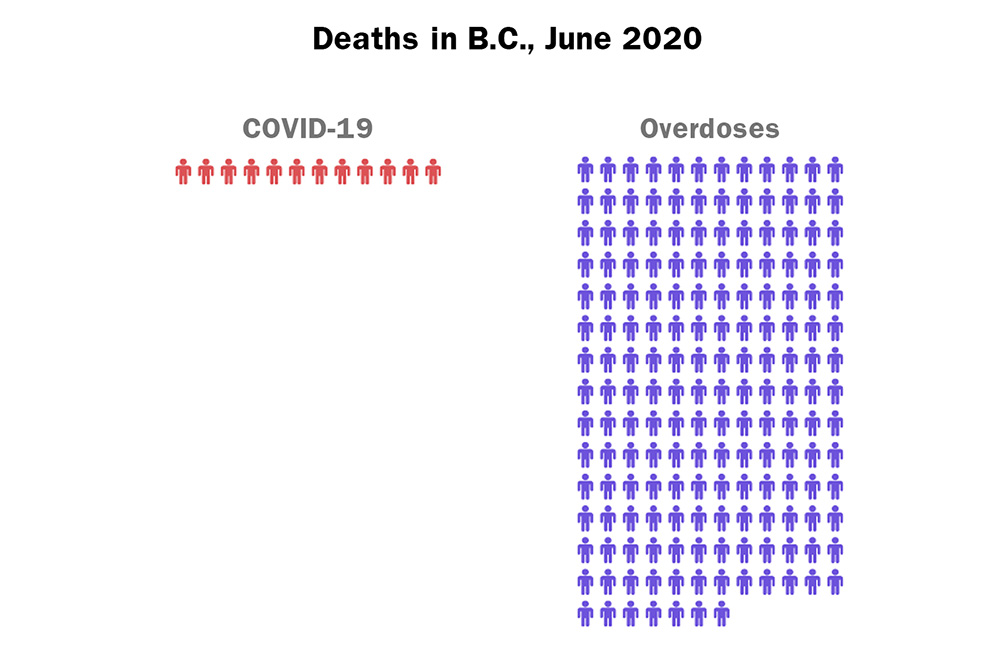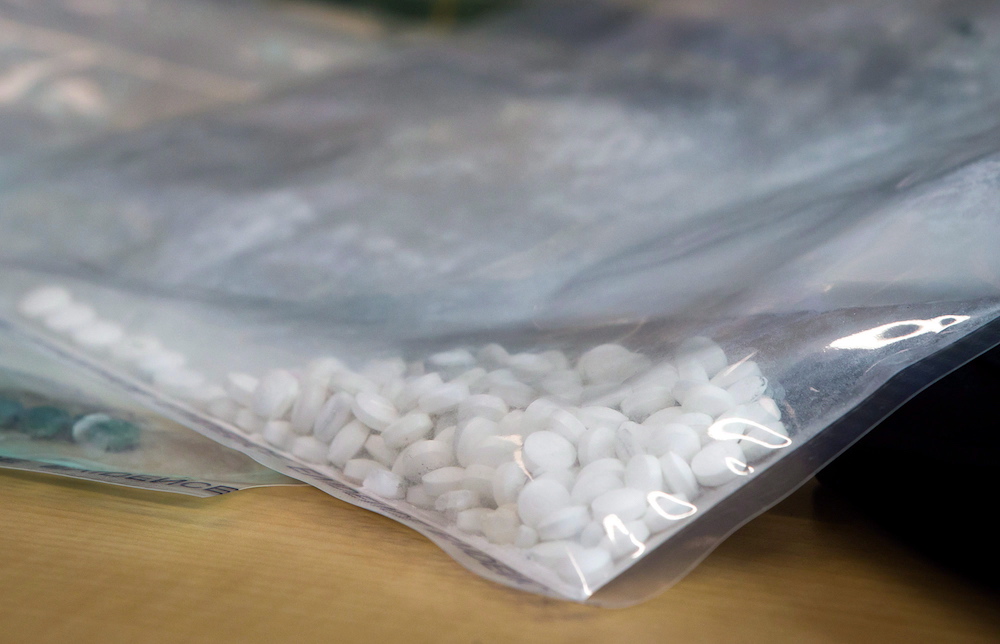British Columbia’s illicit drug supply has become increasingly dangerous during the COVID-19 pandemic as borders are closed and more drugs are manufactured or altered domestically.
Dr. Mark Lysyshyn, deputy chief medical health officer for Vancouver Coastal Health, identified three main sources of contamination.
None are new, but it appears drugs are being made in a clumsier way and with less knowledge of how to get the mix right.
- Fentanyl, the powerful synthetic opioid that has been the main cause of the deadly overdose crisis across North America, is showing up in much higher concentrations.
- Another type of synthetic drug, benzodiazepines, and benzodiazepine analogues — some which are not cleared for human consumption — are increasingly being found in opioids like fentanyl and heroin.
- In stimulants like methamphetamine or cocaine, testing shows fentanyl contamination in about five per cent of the drugs tested.
As people making illicit drugs struggle to access both supplies and the materials they’ve used in the past to cut the drugs, they’re turning to unfamiliar — and risky — substances, he said.
“If you can’t get whatever you’re cutting the precursor with, the fentanyl, then you’re going to use something else like etizolam,” a type of benzodiazepine, said Felicella. But benzos, as the family of drugs is known, add their own risks.
The increasingly toxic drug supply is one factor leading to an alarming spike in overdose deaths starting in March, the month COVID-19 restrictions started.
The number of deaths has continued to rise every month, with 171 people losing their lives to suspected overdoses deaths in May, at that time the highest monthly number ever recorded in the province. In June, the BC Coroners Service reported that 175 people had died of suspected overdoses. The July numbers will likely be reported next week, and advocates don’t expect the trend to improve.

Lysyshyn said the deaths have reversed progress made before the pandemic. “It did seem like over 2019 the drugs, actually, were getting a bit safer,” he said. “We were seeing lower concentrations of fentanyl in drug samples over that year.”
B.C.’s overdose death rate declined dramatically in 2019, from an average of 128 deaths per month in 2018 to 81 per month in 2019.
“But since 2020, we’ve seen them worsen dramatically,” Lysyshyn said.
Lysyshyn said the situation seems to be similar to the early days of the opioid overdose crisis in 2016 when suppliers lacked the skills to produce consistent illicit drugs.
“We think that people were not very good at mixing the drugs together and making drugs to sell on the street,” Lysyshyn added. “And so now we think it’s probably the same thing.”
Pandemic restrictions introduced in March have also had an effect, with fewer people visiting overdose prevention sites where staff can intervene to reverse an overdose. There has also been a slight increase in the number of overdoses that happen outdoors, he said.
“There are fewer eyes on the street right now and fewer people willing to help in case of an overdose,” Lysyshyn said.
“We’re not even supposed to get within two metres of someone, so how are you supposed to help someone having an overdose?”
What’s in the drugs?
Sam Tobias, the senior drug checking technician for the BC Centre on Substance Use, said the unregulated drug supply changes all the time and past checking results don’t necessarily predict what will be in drugs in the future.
Tobias and his team regularly check drugs at several overdose prevention sites in Metro Vancouver.
The BC Coroners Service has reported an increase in the amount of fentanyl seen in postmortem examinations, with an “increase in the number of cases with extreme fentanyl concentrations” in April, May and June. More carfentanil, a very powerful type of fentanyl, has also been found.
Tobias said there has also been an increase in novel psychoactive benzodiazepines being added to opioids like heroin or fentanyl.
Frontline workers have reported encountering benzos overdoses for more than a year in Vancouver, but the percentage of opioid samples that tested positive for benzodiazepines rose from around two to 12 per cent from January to March and to more than 25 per cent by mid-April.
Benzodiazepines like lorazepam and diazepam are commonly prescribed to treat anxiety and act as depressants. But combined with fentanyl, benzodiazepines such as etizolam can complicate overdoses, causing deep blackouts and breathing problems and making them hard to rouse.
The overdose reversal drug naloxone works on fentanyl but has no effect on benzos.
Some of the benzos Tobias and his team are seeing in opioids in Vancouver are unregulated drugs that would not normally be prescribed to people.
“They’re not used in any pharmaceutical drugs, and they often are much more potent than their regulated counterparts,” Tobias said.
“But you can still get them pretty easily by buying them from websites that say these are not for human consumption; they’re research chemicals only.”
Lysyshyn said it’s unclear where the benzos are being sourced and whether they are being added locally or before the drugs are imported.
Felicella said he’s experienced withdrawal from benzos, and it’s awful.
“You want to talk about not feeling human — your soul’s coming out of your skin. It’s like you’re on fire,” he said. “It is just vicious. I’ve gone through withdrawal from benzos and fentanyl — there’s nothing worse than coming off benzos.”
Drug supply disrupted
David Mendes, co-founder of the Canadian Association for Safe Supply, said the pandemic’s effect on the supply of methamphetamine means fentanyl and other opioids are more likely to be added to the stimulant.
“The manufacturers of it in Mexico, which supply 85 per cent of the meth here, are having a problem getting their ingredients shipped to them,” Mendes said.
“Instead of being manufactured fully in Mexico, they’re turning it into powder form, shipping it across that way. Once it gets here, the people here are turning it into meth... and they’re using pretty dangerous chemicals to do it — they’re often using fentanyl and [other opioids] to bulk it up.”
The supply constraints mean the price of meth has doubled, making it more expensive than opioids — a reversal of the usual price dynamic, Mendes said.
Lysyshyn said it’s a concern to find fentanyl contamination in stimulants, because stimulant users may not have any tolerance to opioids and may not be equipped with a naloxone kit or plan to use with others.
The province recently announced funding to expand the number of overdose prevention sites in B.C., including 12 sites for people who smoke drugs.
‘This could be my last time’
Felicella said the situation shows, once again, the importance of developing a more comprehensive safe supply program to limit people’s exposure to unpredictable street drugs.
“Every time knowing, ‘This could be my last time using’ — that’s scary and that weighs a lot of people’s mental health,” he said. “That’s a lot of stress for people to navigate through.”
As part of the response to the COVID-19 pandemic, the B.C. government introduced new guidelines that allowed doctors to prescribe drugs such as hydromorphone, stimulants, benzodiazepines, cannabis and substances to manage alcohol and nicotine withdrawal.
Those changes have made a huge difference for some drug users, while others have struggled to access prescribed drugs.
But Felicella said more needs to be done to expand the range and types of drugs available to provide a viable alternative to illicit drugs.
“We really have to get to that point where we’re saying we have to compete against the fentanyl… and give drug users the drugs that they’ll most likely seek, instead of [things like] methadone,” he said.
Lysyshyn said that while some physicians have been following the guidelines to prescribe alternatives to illicit drugs, it’s still not clear whether that has been enough to reduce overdoses.
What is clear, according to the chief coroner’s most recent report, is that there is “no evidence of a link between increased prescriptions and the increase in deaths.”
“Would the overdose numbers that we’re seeing have been higher if people hadn’t also been prescribing these pharmaceutical alternatives?” Lysyshyn said.
“We’re trying to learn that now, but we don’t have any data that tells us yet.” ![]()
Read more: Health
















Tyee Commenting Guidelines
Comments that violate guidelines risk being deleted, and violations may result in a temporary or permanent user ban. Maintain the spirit of good conversation to stay in the discussion.
*Please note The Tyee is not a forum for spreading misinformation about COVID-19, denying its existence or minimizing its risk to public health.
Do:
Do not: